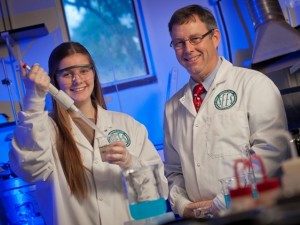As essential as wastewater treatment facilities are to a modern society, not many people want to spend time in close proximity to these typically loud and foul-smelling plants.
But what if there was a quieter, chemical-free, odorless way to treat wastewater? And what if it doubled as a thriving ecosystem of plants, fish, and many other organisms?

Sarah Hardy ’14 and Professor Art Kney in Acopian Engineering Center
These aquaponics systems—often referred to by their trademarked names of Living Machines or Eco Machines—are an emerging field. Civil engineering major Sarah Hardy ’14 (Rowley, Mass.) is leading a team of students who are researching the potential applications of aquaponics in wastewater treatment.
In support of her research, Hardy has received a $48,900 Environmental Protection Agency Greater Research Opportunities Fellowship. The award provides tuition assistance and research funding. Recipients also serve a summer internship at an EPA facility. The EPA awards approximately 40 of these fellowships each year.
Hardy, along with Alexa Gatti ’16 (Whippany, N.J.), Sally Trout ’16 (Seven Valleys, Pa.), and Ben Nitkin ’15 (Newton, Mass.), are studying a system installed at Penn State University that uses organisms to treat effluent from an academic building.
The system uses a series of tanks growing plants, fish, bacteria, and fungi that convert raw sewage into clean water in a matter of days. As the waste material moves through the tanks, the mini-ecosystems in each one break it further down.
Based on what they learn from Penn State, the students will be recreating small-scale models of segments of the system—open aerated tanks and indoor wetlands—to determine the effectiveness of various plants at treating wastewater.
From their research, they will propose how parts of the system could be integrated into the Easton Waste Water Treatment Plant’s conventional treatment operation. On campus, the team will be working with Arthur Kney, associate professor and head of civil and environmental engineering.
“I’m passionate about creating innovative solutions to community problems through engineering designs that are both more natural and more efficient,” Hardy says. “Eco-machines relate to my area of interest perfectly in that they are comprised entirely of natural components that perform a societal function at a lower cost while adding aesthetic value to the community.”
Hardy is interested in going to graduate school after Lafayette to further pursue her interests in environmental engineering.
“By incorporating environmental, ecological, geotechnical, water resources, etc. knowledge into engineering design, I can find more sustainable ways to manage storm water, wastewater treatment, mitigate urban heat effects, and countless more applications,” she says.
See a list of recent Lafayette recipients of national and international scholarships and fellowships for undergraduate and post-graduate study
For information on applying for scholarships and fellowships, contact Julia A. Goldberg, associate dean of the College, (610) 330-5521.

2 Comments
I think part of the problem of odor coming from sewage treatment plants is that they are operating past their design capacities and the system installed isn’t being properly maintained. In many older cities some storm water is still being channeled into the waste water stream going to the treatment facility, which overloads the system during heavy rain. Proper maintenance is also essential to eliminating odors in the neighborhood and in keeping proper chemical balance in the effluent. My wife grew up a mile downwind from the Bangor Pa. sewer plant and the small stream into which they sent their effluent ran right by their house. If the plant wasn’t working right you knew it.
Good luck in your research. If it scales up to handle more waste water than that coming from one building, the system described above could very easily be the way to go. It may still need a coagulating section to remove pollutants like trace amounts of metals, but this is surely a good start.
Comments are closed.